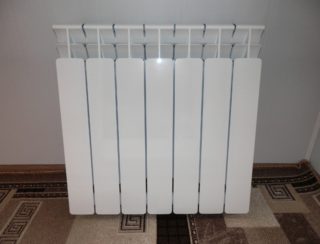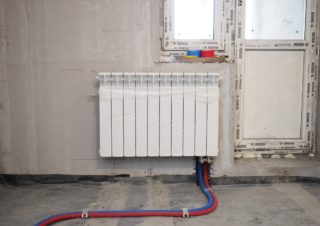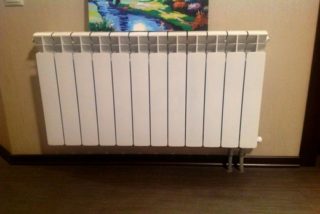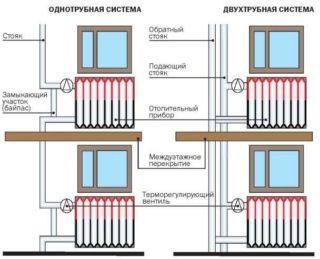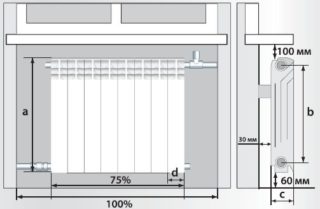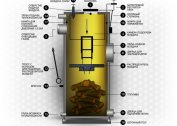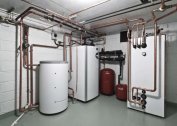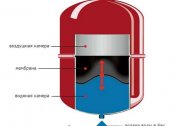Rifar base 500 is a sectional type radiator from a Russian manufacturer. The main advantage is high power, so the battery is ideal for large rooms. Some models have a curvature, so installation is possible along walls of any radius, window sill height and window width.
Radiator description
Each section of the base 500 radiator is a single steel pipe filled using aluminum alloy with special technology under high pressure. This allows you to increase the life of the device and its strength. The steel core has a low heat transfer, and the aluminum core has a high one.
The sections are interconnected by a silicone gasket, due to which a durable monolithic product with leakage protection is obtained. Inside the radiator is covered with a special protective layer, on the outside - with a powder paint that protects against corrosion and damage. The distance between the axes of the radiator is 500 mm.
The heat carrier in bimetallic radiators is specially prepared water, therefore it is forbidden to use non-freezing liquids, antifreezes. Permissible hydrogen index is 7-8.5. When using another agent, the performance of the radiator will be doubtful.
The manufacturer Rifar puts the only restriction on the operation of radiators: you can not use them in rooms with a humidity of more than 75%.
Specifications
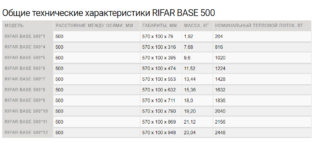 The model range, depending on the heat transfer and the number of sections, allows you to choose a device for any room. The height of the radiator is 570 mm, the depth is 100 mm for all models, the width of one section is 7.9 cm. The full width starts with an indicator of 320 mm, each next model increases by 16 mm (the last - 1120 mm). Similarly, with the nominal heat flux: the initial indicator is 816 W, the final indicator is 2856 W, each next model is 408 W more. The layout of the number of sections can be different: possible options are from 4 to 12, although a minimum quantity of 2 pieces is allowed, a maximum of 24 pieces.
The model range, depending on the heat transfer and the number of sections, allows you to choose a device for any room. The height of the radiator is 570 mm, the depth is 100 mm for all models, the width of one section is 7.9 cm. The full width starts with an indicator of 320 mm, each next model increases by 16 mm (the last - 1120 mm). Similarly, with the nominal heat flux: the initial indicator is 816 W, the final indicator is 2856 W, each next model is 408 W more. The layout of the number of sections can be different: possible options are from 4 to 12, although a minimum quantity of 2 pieces is allowed, a maximum of 24 pieces.
The number of sections can be calculated in two ways. In the first case, the footage of the selected room must be multiplied by 100. The resulting figure must be divided by the heat transfer coefficient, which corresponds to 1 section of the selected model. In the second case, the area of the room must be divided in half. But this is relevant only with a center distance of 500 mm.
The main condition for choosing - the length of the window opening should be equal to the length of the radiator or be two-thirds of its part.
Performance data:
- The surface of the coolant reaches a temperature of up to 135 ° C.
- The nominal working pressure is 20 atmospheres (2 MPa), although during testing these indicators reached 30 atmospheres.
- The power of one section varies from 0.104 kW to 0.204 kW.
- Operational resource - 25 years.
- Warranty from the manufacturer is 10 years.
According to the type of connection, the radiator Rifar base 500 is divided into 2 types:
- With side connection “Ventil”. At the bottom of the circuit is a node with which to connect. The removal of the heat agent occurs through the lower channel, and the supply takes place from above. In addition, the Rifar base 500 bimetallic radiator models allow you to control surface heating to change heat transfer and temperature, just put the thermostatic head on the thermal vent. The only problem that can occur with this type of radiator connection is uneven heating of the sections, but this is an easily fixed error. It is enough to install a flow extension according to the “top-bottom” scheme to ensure intensive circulation of the coolant.
- With the bottom connection - bvl (left) and bvr (right). Such a system has a stable operation and does not require the installation of additional elements. To squeeze air out of the device, you need to connect the thermostatic head and the Mayevsky crane (needle air valve). All that remains is to turn the tap counterclockwise and wait for the air bubble to come out.
A radiator is supplied with a ½ or ¾ inch universal mounting kit, a universal and standard floor bracket, an adjustable and standard corner bracket, and an anchor bracket.
Benefits of Rifar Radiators
The distinct advantages of the Rifar b 500 radiator include versatility. Mount it in apartment buildings where central heating is used, and in private houses. However, in the latter case, you should not use an autonomous system. It would be much better to connect the radiator to a centralized heating system.
Temperature regulation is another plus, however, to connect you will need to purchase a separate thermal head, thermal valve, radius thermostat, and thermal valve. For installation - 4 adapters, a tap for air exhaust, a plug.
Given the small internal volume of 1 section of the radiator Rifar bimetal 500 0.136 kW, low inertia is easily achieved. A small volume allows you to quickly heat the room and quickly cool. This is appropriate if a higher temperature is needed during the day and a lower temperature at night.
A polyurethane sleeve is a part connecting the sections to each other, due to which tightness is achieved. In addition, laser welding of heating equipment contributes to tightness.
The solidity of the radiator allows you to do without special adapters during installation.
Beautiful design also refers to the advantages, the manufacturer allows the device to be painted in any desired color.
Connection Features
It is quite simple to connect bimetallic radiators of the Rifar b 500 brand. However, it is worth considering a couple of nuances:
- Before installation, the temperature of the radiator and the room must match.
- Zeroing, grounding or wiring of dielectric materials is a prerequisite for extending the life of the device and to prevent premature corrosion.
The most detailed installation instructions for the bimetallic radiator are always included.
- Polypropylene pipes reinforced with aluminum or fiberglass - a good combination. As a result of this, the cleaning process and the use of a shaver disappears, and the installation time of the radiator is reduced. It is allowed, but not welcomed, to install metal-plastic pipes with a collet clamp or steel (iron) pipes.
- Before installation, the working area is cleaned: the pipeline is removed from the riser, installation sites are marked and holes for brackets are drilled.
- From the floor to the bottom of the radiator, the distance should vary from 60 to 120 mm. Above or below specified limits will result in a reduction in heat transfer. Also, behind the wall of the radiator to the wall should remain 20 mm, and between the windowsill and the upper part of the radiator - at least 50 mm. This distance contributes to ease of installation and improves convection.
- Mount the radiator strictly horizontally in the center under the window. If there are additional radiators in the room, their level must strictly correspond.
- Drill holes on the wall, fix the brackets with dowel nails with cement mortar. For reliable fastening of the radiator, the hooks must pass freely between the collectors.
- Prior to installation, the radiator itself is equipped with all the necessary additions: futors and adapters at the points of connection with the pipes, a Mayevsky tap to remove excess air.
- The riser is closed and pipes connected with or without bend are connected.
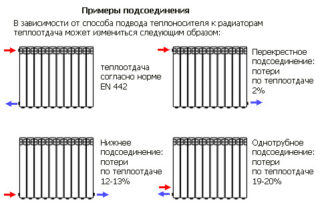 The connection scheme can be traditional, lower or diagonal.
The connection scheme can be traditional, lower or diagonal.
With a traditional or lateral connection to the pipe located on top of the radiator, a pipe is connected that supplies the coolant. And a downpipe is mounted to the lower pipe.
The lower wiring diagram is used when the system is installed in the flooring or hidden. On the opposite sides of the radiator, pipes for supplying and discharging the coolant are connected to the pipes from below.
The diagonal circuit is ideal for radiators with a large number of sections. A supply pipe is connected to the upper pipe, and to the lower pipe, on the other hand, is a heat transfer pipe.
After the done manipulations, the system is filled with coolant, for which the stabilizing valve is closed by about two-thirds, so that there is no water hammer.
